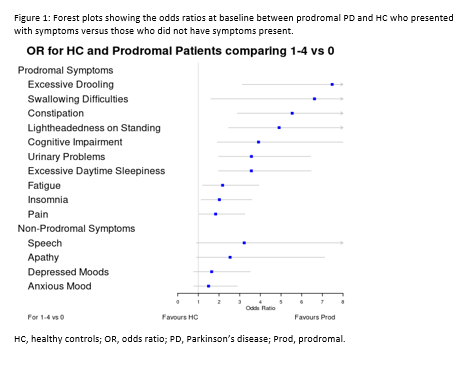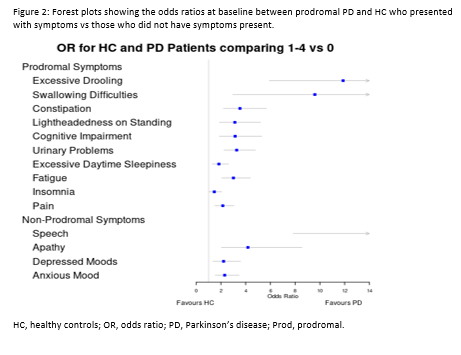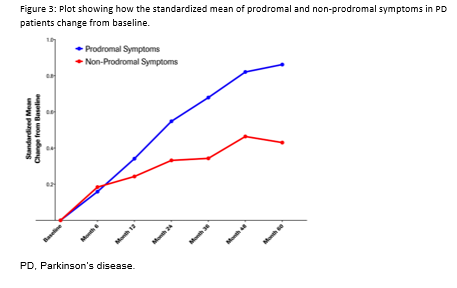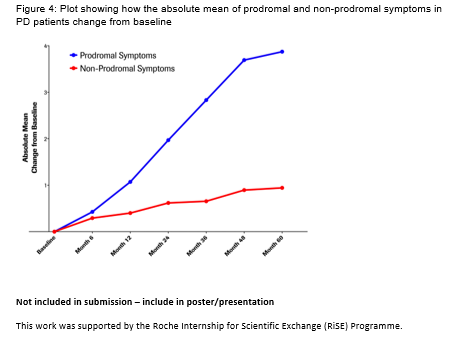Category: Parkinson's Disease: Non-Motor Symptoms
Objective: To define a subset of Parkinson’s disease (PD) symptoms that are present in both individuals with early PD and prodromal PD, compared with age-matched healthy controls (HC).
Background: PD pathology can start many years before the onset of motor symptoms and disease progression is slow and heterogeneous. This represents a key limitation for clinical trials of drugs designed to slow disease progression. Disentangling prodromal (symptoms that start before motor onset) from non-prodromal (symptoms that start after motor onset) PD may be useful in clinical trials as their progression rates may differ.
Method: By using the Movement Disorders Society-Unified PD Rating Scale (MDS-UPDRS) individual items, we compared the presence of non-motor symptoms, excessive drooling, speech and swallowing difficulties between 422 individuals with early PD, 64 individuals with prodromal PD and 195 age-matched HC from the Parkinson’s Progression Markers Initiative (PPMI). Odds ratios (OR) with 95% confidence intervals were calculated between early PD, prodromal PD and HC, with a score ≥1 used to indicate the presence of each symptom. Symptoms present in both prodromal-PD and early-PD populations were defined as prodromal, while the other symptoms were considered non-prodromal. In the population of early PD, we compared the progression of prodromal and non-prodromal symptoms over 60 months’ follow-up.
Results: The following symptoms were defined as prodromal symptoms (as they were present in both early PD and prodromal PD compared with HC): Excessive drooling (OR=11.88), swallowing difficulties (OR=9.59), constipation (OR=3.54), urinary problems (OR=3.27), lightheadedness (OR=3.12), cognitive impairment (OR=3.15), fatigue (OR=3.01), pain (OR=2.15), excessive daytime sleepiness (OR=1.83) and insomnia (OR=1.46) (Figures 1 and 2). Anxiety, depression, apathy, and speech difficulties were present in early PD but not in prodromal PD, and were defined as non-prodromal symptoms. In the early-PD population, the progression of prodromal symptoms was faster than non-prodromal symptoms (Figure 3 and Figure 4).
Conclusion: Subgrouping MDS-UPDRS individual items in prodromal versus non-prodromal symptoms is possible. Non-prodromal symptoms change little over time. Longitudinal follow-up of prodromal items of the MDS-UPDRS may have a higher sensitivity to change and hence, may be more useful outcomes in clinical trials of early-PD and prodromal-PD populations.
To cite this abstract in AMA style:
H. Jackson, J. Anzures-Cabrera, T. Simuni, R. Postuma, G. Pagano. Disentangling prodromal from non-prodromal symptoms of Parkinson’s disease [abstract]. Mov Disord. 2021; 36 (suppl 1). https://www.mdsabstracts.org/abstract/disentangling-prodromal-from-non-prodromal-symptoms-of-parkinsons-disease/. Accessed December 14, 2025.« Back to MDS Virtual Congress 2021
MDS Abstracts - https://www.mdsabstracts.org/abstract/disentangling-prodromal-from-non-prodromal-symptoms-of-parkinsons-disease/




